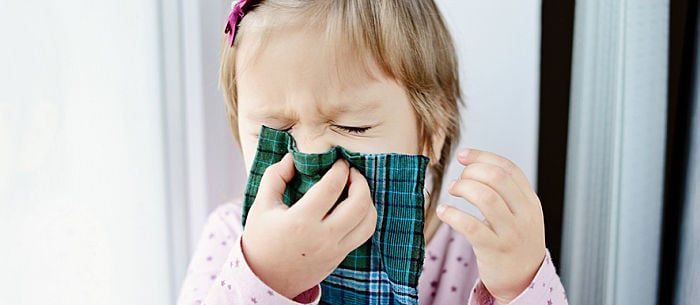Your toddler just broke out in a rash, and you wonder whether he could be allergic to the melon he had for lunch or if he’s reacting to pollen in the air today. How can you tell the difference between toddler allergies and normal colds or rashes? Understanding how to identify allergic symptoms and treat them quickly can make you more confident if your child does experience seasonal allergies or an allergic reaction to a food.
Identifying Symptoms of an Allergic Reaction to Food
If your toddler experiences an allergic reaction to a food, you may see one or more symptoms. Some children experience dermatological issues, such as hives or eczema. Others may experience some degree of respiratory distress, such as wheezing, difficulty breathing or repetitive coughing. “Often, breathing problems are mistaken for colds or respiratory infections,” says Dr. James R. Baker, Jr., the CEO of Food Allergy Research & Education (FARE).
“It is only when they are associated with rashes that parents understand that they may be related to an allergy.” Abdominal problems such as pain or vomiting may also result from an allergic reaction.
Many parents overlook behavioral signs that occur before or during an allergic reaction, points out Dr. George Du Toit, a consultant in pediatric allergy and honorary senior lecturer at Guy’s and St Thomas’ NHS Foundation Trust. “If a child is eating a meal and happily interacting with an electronic device, a normal situation in the modern age and then suddenly starts looking apprehensive or becomes unusually clingy … it may be related to anaphylaxis,” says Dr. Du Toit. Children with allergies may also have an aversion to foods containing the allergen.
Toddler allergies may not show up until the second or third consumption of the allergen or longer, for milk and wheat allergies. Allergic reactions usually occur within twenty minutes of eating the allergen. More severe allergic reactions in toddlers usually begin as milder reactions, but can progress to severe respiratory distress, crippling abdominal pain or anaphylactic shock.
If mild symptoms are treated quickly, systemic reactions can often be avoided. Because allergic responses can worse with each exposure, if you notice even mild allergic symptoms in your child, you need to find out the cause.
Seasonal and Environmental Allergies
Most children who will develop environmental or seasonal allergies experience no symptoms during the first two years of life. Very rarely, children may present with symptoms at age 1, says Dr. Baker, especially when exposed to dust mites or animal fur.
Most children do not start to show sensitivity to tree or grass pollen (the causes of seasonal allergies), however, until they are between ages 3 and 5, says Dr. Du Toit. According to the American Academy of Pediatrics, symptoms of seasonal allergies in toddlers may include a runny nose, itchy eyes, wheezing or sneezing.
Other environmental allergens, such as indoor molds, dust or animal dander, can begin to cause allergic symptoms much earlier than seasonal allergies appear. Both seasonal and other environmental allergies can be diagnosed through skin-prick tests in which the skin on the arm or back is very lightly pricked and a tiny bit of allergen touched to the skin to see if redness or a small welt or hives appear or blood tests that determine the body’s reactions to each possible allergen. While uncomfortable, seasonal and environmental allergies aren’t usually considered dangerous conditions.
The Right Parental Response
Treatment options for seasonal and environmental allergies in toddlers depend on their symptoms. If your child’s main symptom is mild congestion, a nasal saline rinse may solve the problem. More severe symptoms may be treated with non-drowsy antihistamines, eye drops or a stronger nasal spray, if your child’s doctor recommends these. Preventative allergy shots are usually not recommended for children under age 5.
If you think your child is experiencing an allergic reaction to a food, stay calm. Milder reactions may be treated with an over-the-counter antihistamine, such as Benadryl (of course if your child is having trouble breathing, call 911).
If an antihistamine does not resolve the symptoms, however, it is important to call a local emergency number immediately. Emergency personnel will probably attempt to stop the reaction with an injection of epinephrine, a form of adrenaline that can stop an allergic reaction in its tracks. Albuterol may be used to treat wheezing or other respiratory issues.
After the situation resolves, it is essential to have your toddler evaluated by a board-certified allergist.”Food allergies are potentially life-threatening and should be taken seriously,” says Dr. Baker. The allergist will ask you questions about your child’s medical history and conduct testing to identify any allergies that your toddler might have. Dr. Baker also encourages parents of allergic toddlers to fill out a food allergy and anaphylaxis emergency care plan together with the allergist.
To learn more about allergies, read Honey for Allergies: Is It Safe for Kids?
Keren Perles is a freelancer writer who has written hundreds of articles about kids and childhood health. With three young children of her own, she knows the struggle of connecting every rash and sniffle to an allergic reaction.
* This article is for general informational purposes only. It is not intended nor implied to be providing medical advice and is not a substitute for such advice. The reader should always consult a health care provider concerning any medical condition or treatment plan. Neither Care.com nor the author assumes any responsibility or liability with respect to use of any information contained herein.






